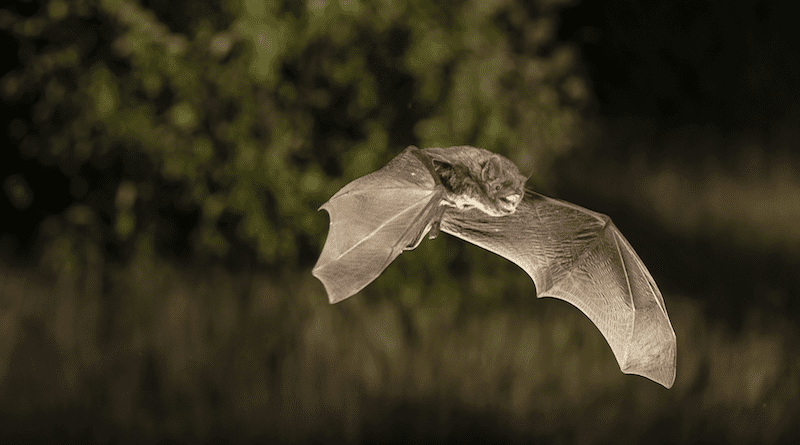Bat Seasonal Migration Is More Complex Than Previously Assumed
In late summer, some bat species migrate from northern Europe along the coastlines to their wintering sites in central and western Europe. Until now it was assumed that all bats travelled in the same direction during the migration. However, the reality is more complex: On the Latvian Baltic coast, a research team led by the Leibniz Institute for Zoo and Wildlife Research (Leibniz-IZW) reconstructed the flight paths of Nathusius’ pipistrelle bats using ultrasound microphones.
Most animals flew southwards in late summer, but on some days 20 percent travelled in the opposite direction – presumably owing to weather conditions. More and more wind turbines are being set up along the coasts and on the high seas of the North Sea and the Baltic Sea. As bats spend more time along the coastlines than expected, partially deviate onto the high seas and even fly detours, the wind turbines pose a more (deadly) danger to bats than previously recognised, the team concludes in an article in the journal “Global Ecology and Conservation”.
The Nathusius’ pipistrelle (Pipistrellus nathusii) holds the long-distance world record for seasonal migration among bats. Specimens ringed in the Baltic States and Russia were found more than 2,000 kilometres away in northern Spain. This is a considerable achievement for an animal weighing only eight grams. During migration, the animals should therefore head straight for their wintering areas. Nathusius’ pipistrelle bats migrate particularly along the coastlines of the North Sea and the Baltic Sea. Such migration corridors are like highways for migrating animals. Until now it was assumed that the bats only travelled in one direction on these highways in late summer, southwards towards their wintering areas in central and western Europe. Other patterns of travelling would cost energy, which would be sorely needed for hibernation in the wintering area.
“Nathusius’ pipistrelles from the Baltic region also could, in addition to their main southerly migration direction, also fly northwards to then cross the Baltic Sea westwards from Finland to Sweden”, says Christian Voigt, head of the Department of Evolutionary Ecology at the Leibniz-IZW. “As bats are difficult to observe owing to their small size and nocturnal lifestyle, we had to use a special technique to reconstruct the flight routes and verify or refute this idea.” Bats emit high-frequency calls inaudible to humans for foraging and for orientation at night. Such echolocation calls can be recorded using ultrasonic detectors. If several ultrasonic detectors are operated in synchrony, the spatial position of the bat can be determined from differences in propagation time resulting from different distances between the bat and the microphones.
“We used a system of eight ultrasonic microphones mounted on a metal rod at a defined distance from each other and were thus able to determine the exact spatial position of individual bats”, explains Jens Koblitz from the Max Planck Institute of Animal Behaviour. “The flight path of each recorded bat can then be reconstructed from successive spatial positions.”
In this way, the team recorded the flight paths of more than 400 migrating Nathusius’ pipistrelles on the Latvian Baltic coast during three summer nights. Most bats travelled southwards along the coastline. However, on one day the scientists observed that 20 percent of the animals flew northwards, whereas the majority took the obvious route southwards. The reasons for this are still unclear. It is possible that unfavourable weather conditions on the migration route caused some bats to head north and opt for an alternative route. Or they only flew a short distance back along the migration corridor to wait for favourable conditions for their onward flight.
“Every year we discover new interesting details about bat migration”, says Gunārs Pētersons, professor at the Latvia University of Life Sciences and Technologies in Jelgava, summarising the results of the scientific investigation. “However, I am concerned about the directional changes of the flight paths of bats, as there are more and more wind turbines along the coastlines and on the high sea, and such changes imply that the animals will be travelling for longer periods of time in these dangerous zones if they don’t choose the most direct route.”
Thousands of wind turbines are currently in operation in countries bordering the Baltic Sea and North Sea or will be installed in the near future, as coastal locations promise strong and constant wind and therefore high energy production. As particularly migratory bats can die at wind turbines, wind energy production on the coast and the high seas is potentially in conflict with conservation objectives.
“Migratory species are particularly susceptible to habitat changes, as they are dependent on each of a variety of habitats providing the right living conditions at the right moment. For the Nathusius’ pipistrelle, for example, every ecological stepping stone between the breeding grounds in the north and the wintering areas is crucial”, says Christian Voigt. “That’s why migratory birds and bats are under the special protection of the United Nations Environment Programme. Germany and many countries bordering the Baltic Sea and the North Sea have made a contractual commitment to protect migratory species. In addition to EU conservation law and national conservation law, the UN Convention on the Conservation of Migratory Species requires the countries bordering the Baltic and North Seas to ensure that migratory bats can move safely between their summer and winter habitats.”
In their paper, the scientific team therefore calls for wind energy development at coastal sites to be carried out with great care and caution. Sufficient space should be left for migrating bats. Only then will long-distance migrants such as the Nathusius’ pipistrelle reach their destination also in the future.

